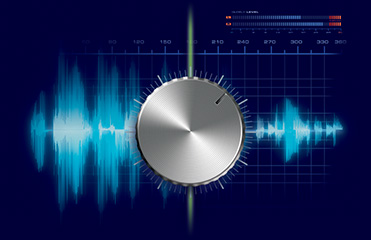Sound scale
Note, Sound, Noise… what is the difference?
When a sound source vibrates, it forces the surrounding layers of air to vibrate as well. The vibration gets transferred gradually from one point to the next and it produces the phenomenon of wave propagation. When one of these layers of air reaches our eardrum, we hear a sound. The sound is characterized by several physical criteria such as intensity, frequency, spectrum and duration.
The sound’s intensity depends on the amplitude of the vibrations. The greater the amplitude of the vibrations, the greater the intensity of the sound. We can describe a sound as being loud or quiet. Sound intensity is a relative characteristic. And so, if we compare the intensities of one sound to another and perceive the second sound as being more elevated, the second sound would then be louder than the first one.
The pitch of the sound perceived by our ear depends on the frequency of the sound. The sound frequency is a function of the vibration velocity of the sound source. Indeed, the faster the source vibrates, the higher the frequency of the perceived sound, and the more we perceive the sound as high-pitched. Inversely, the slower the source vibrates, the more we perceive the sound as low-pitched. Not all frequencies are audible by the human ear. Only the ones between 20 and 20 000 Hz can be perceived by it. We are able to distinguish three big frequency ranges: low frequencies (20-500 Hz), medium frequencies (500-3 000 Hz) and high frequencies (3 000 Hz-20 000 Hz). A person can emit frequencies between 85 and 1 100 Hz, but certain animals can produce frequencies which are sometimes inaudible for the human ear. Bats produce ultrasound, whose frequency is over 20 000 Hz (up to 120 000 Hz!). As for elephants, they produce infrasound, whose frequency is lower than 20 Hz. This infrasound can be heard by other elephants within 10 kilometres, depending on the weather conditions.
A sound consisting of a single frequency is called a pure sound. In nature, it is very rare to hear a pure sound. Unlike pure sound, a sound consisting of multiple different frequencies is called a <acomplex sound. Certain devices used for performing acoustic measurements emit pure sound, while all musical instruments produce complex sounds. Sound emitted from musical instruments consists of a principal vibration which is called fundamental, on which other vibrations are superimposed. The frequencies of the additional vibrations are integer multiples of the fundamental frequency. These additional vibrations are named harmonics, and their intensity determines the timbre of the note.
The timbre is a characteristic which allows us to differentiate two sounds with equal pitch and intensity. In music, it allows us to differentiate the instruments. The timbre of a sound played by a musical instrument depends in particular on the harmonics which constitute it. There are many adjectives used for describing the timbre of a sound. If we take for example the same music note, having the same pitch as well as the same identity, played on two different instruments: the transverse flute and the oboe. The sound of the transverse flute can be described as clear and round, while the one from the oboe can be described as more piercing.
We have seen that notes played by musical instruments are complex sounds consisting of a fundamental frequency and multiple harmonics. The majority of sounds in the environment are not constituted of such harmonic spectres, but rather of noise. In humans, noise often produces an unpleasant sensation. Certain specific noises are used during acoustic measurements such as white noise and pink noise. Other measurement signals such as a sweep sinewave or modulated sounds can also be used for this purpose.
Building Acoustics
Some of the parameters described above allow us to define certain features in the field of building acoustics. Building acoustics involves studying these features, which are often based on acoustic measurements. Among the more frequently studied criteria are sound reverberation and the interior and exterior insulation of airborne as well as structural noise.
Reverberation is a feature that plays an important role in speech intelligibility and music perception. The measurement performed in building acoustics is named RT for Reverberation Time. The duration of the reverberation time of a room (from 0.5s in an apartment room to over 6s in a cathedral!) directly influences the perception of a spoken message in this room. And so, when a person speaks in an anechoic chamber, we hear this, whereas the same speech in a reverberant chamber sounds like this.
Insulation against airborne and structural noise, as well as vibrations, is a very important element during the construction of a building or a transport infrastructure. The following examples allow us to quickly understand this notion. The capacity of a window (or any other construction element) to insulate noise is defined by its sound reduction index R. The higher this index is, the more the window can insulate. Let’s take as an example a window with a double glazing. If the window is open towards a boulevard, we can distinctly hear the passing of cars. However, if the window is closed, the noise from cars is less perceptible. A window with a higher sound reduction index, the exterior noises would be even less perceptible. In the same way, if you play a piano in a room and the door separating it from another room is open, a person in the neighbouring room could hear it too. Moreover, if the door is closed and is able to insulate very little, the person in the other room could hear this too. In order to hear the piano as little as possible, a door with a high sound reduction index would need to be installed.
If you live in an apartment and you listen to music in your living room, it can mean that your neighbours could hear it as well, and moreover, differently to how you hear it! This differing perception is due to the insulating features of the separating partition between the rooms. In the case of an 18 cm thick concrete wall, if you are listening to rock music, your neighbour could hear it as well. We could notice that the low frequencies are more perceptible: they are the ones which are the most difficult to treat. To attenuate their propagation, we would have to treat the source and insulate the speakers (which are playing the music) from the ground. This way, we treat not only the vertical propagation of structural noise between two rooms one on top of the other, but also laterally between two rooms on the same floor, or diagonally between two non-adjoining rooms on the same or on different floors. This is a frequently occurring phenomenon when impact noises are generated by footsteps, falling objects or moving furniture on a harder surface. To reduce the nuisance caused by impact noise, the ground can be covered with a textile floor covering (carpet, rugs, etc.), a plastic floor covering, or a tiling placed on top of a resistant layer. It is also possible to create an interruption between the transmitter of the nuisance and the receiver, by separating elements of the structure such as a floating ground system, buildings on springs, etc., the latter solution being commonly used in treating nuisances from land transport.
In some circumstances, a simple way to protect our hearing is to wear earplugs. For example, when an airplane takes off, at a certain distance we hear this. Thanks to the earplugs, which are able to attenuate the higher frequencies more than the lower ones, at the same distance, the sound of the plane is more muffled, less loud and it sounds like this. This way, our hearing system is partially protected.
Sound samples
User notice
The sound samples are provided for informational purposes only. They serve as examples to illustrate sound situations which may be encountered in specific circumstances, and can in no way constitute a basis for any acoustic study. The levels of the different sound samples are not absolute levels. Please adjust your output device so that you can hear the quietest sample correctly (Restful-Forest noise).

